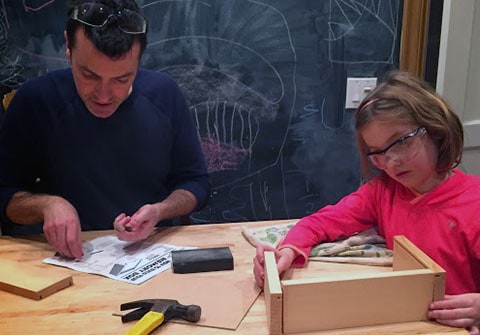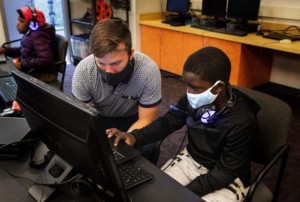10 Ways To Inspire A Love Of Learning

In 2008, Jessica Seinfeld released a cookbook for parents called “Deceptively Delicious.” At the time, I was a newly-minted mother of a solid-food eating child. Seinfeld’s book was all the rage among the other new mothers in my mama tribe. The recipes were “stealthily packed with veggies hidden in them so kids don’t even know!”
Yeah, I ordered a copy faster than a new parent can say “Amazon Prime.”
But one day, as I watched our young daughter polish off yet another bag of organic Just Peas, it occurred to me – the girl loved vegetables. LOVED them. I didn’t need a cookbook to help me trick her into liking them. Instead of hiding chickpeas in the chocolate chip cookie batter or sneaking pureed squash in the mac & cheese, serving up the healthy stuff, then modeling and reinforcing just how good and healthy it was seemed to be the “trick.”
Seven years later, we have a second grader who has never met a fruit or vegetable she won’t taste, picks Saag Paneer at Ambar to celebrate every birthday and packs salads for school lunch. I feel like maybe we did something right.
Could a similar, intentional approach to learning have the same results?
Instead of “sneaking learning” inside of educational games and activities, what if instead we had conversations with our kids about what piqued their curiosity, what they wanted to know more about, what they wanted to experience and how they could share what they had learned?
Guided by those questions, “The intentional weekend” was born.
Just like parents can teach their kids to lead healthy lifestyles by being intentional with them about how to make healthy choices, parents can also be intentional about modeling the importance of learning new things, having new experiences and challenging ourselves in new and meaningful ways.
Here are 10 recommendations for being intentional about inspiring lifelong learners, based on experiences from our family.
- Use a rainy or snowy day to learn something totally new together. One snow day, my daughter and I tried “Hour of Code” and I was amazed at how much she learned about coding and how much I learned about her.
- Launch an experiment that brings learning to life.An afternoon getting inspired by an online “Stick Bomb Tutorial” taught us more about kinetic energy than we could ever learn in a textbook. It was so cool that the kids insisted we make some videos and share them with their friends. We uploaded the videos to Instagram and Facebook and the kids were so excited to learn that they inspired other friends to build their own stick bombs at home!
- Get out and explore. There’s definitely benefit to roaming around the woods without an agenda, but that doesn’t mean learning can’t happen there too. Just last week a bike ride turned into some impromptu trail blazing through a community nature preserve. We pointed out signs of changing seasons, compared natural and man-made things along the trail, identified fungus on logs, talked about compost and more. That 20 minute hike yielded a solid week’s worth of science lessons.
- Take on personal challenges (and talk about overcoming them). We’re intentional about discussing how brains learn and even our 4 year old can describe how challenging a brain to learn something new helps it “grow.” We talk a lot about the importance of taking on mental and personal challenges, then spend time reflecting on how that experience felt and how it improved us. It’s important that inspiration flows both ways. So, for example, I recently shared with our 7 year old that the way she really pushed herself to beat an end-of-season personal best in swimming butterfly inspired me to push myself to beat my personal best mile sprint time on the spinning bike. (See Eduardo Briceño’s “Growth Mindset Parenting” for more on how to develop growth mindsets in children.)
- Turn something passive into something active. Not every second of every day has to be tied to a specific learning goal, but there are times when parents can get creative in order to turn something passive into an active learning opportunity. Our youngest daughter is fascinated by toy review videos featuring other kids on YouTube. We’d rather her not spend too much time passively watching these videos, so instead I asked “Wouldn’t you rather learn how to make your own video?” and voila! We encouraged the kids to set up their own set, make their own versions of the expensive toys on the YouTube channels and film their own reviews. Then we used imovie to make their own video and publish it online.
- Seek answers together. We have a rule around here that questions get answered to the best of our ability. “Just because” and “I don’t know” are off the table. Instead, if one of the kids has a question or one of us is curious about something, we’ll find the answer together. This works well for a few reasons. It teaches kids to follow their intellectual curiosities and that their interests have value, while at the same time giving them real, authentic practice with research. Although the library can be a great way to spend an afternoon, not everything has to be a full research project. In our family, it’s sometimes as simple as using google to find the origin of the phrase “getting a Charlie horse” or finding out all the ingredients in McDonald’s Shamrock Shake.
- Join (or start) a family book club. Since my oldest daughter was in Kindergarten, we’ve been in a monthly mother-daughter book club. Each month we rotate as the hosting family. We chose the book for everyone to read then lead the book talk, do a craft or activity, have a potluck dinner and spend time together. Our book club is focused on books that have strong female characters, but book clubs can be built around any theme or goal. One of my favorites was when we read “The Evolution of Calpurnia Tate” and, in the spirit of the main character, shared information about female scientists with our daughters and set up our own naturalist club for the afternoon – putting backyard discoveries under the microscope and adding them to our nature journals.
- Cultivate an interest in the arts. Research supports the value in exposing children to the arts and doing so doesn’t have to be expensive. We try to expose our kids to diverse experiences from bluegrass to ballet and from the contemporary art to the classics. Seek out opportunities for free community concerts and family nights at local museums. We’ve also been pleasantly surprised by the number of options on services like Amazon Streaming Video and Netflix to watch recorded videos of plays, concerts and shows like Cirque du Soleil. (See Mary Ryerse’s “Music Builds Maker Mindsets” for more on the power of performing arts.)
- Stop and smell the roses. Reflection is an important part of learning, so we try to create opportunities for our kids to slow down, practice mindfulness and reflect on the world around them. We like to collect treasures on our neighborhood walks and make nature mandalas when we get home.
- Everything is an opportunity to learn. Parents, keep having fun with your kids and don’t be afraid to tell them they’re learning. Teach them learning is fun, motivating and rewarding. Go rock climbing and talk about pulleys. Set up a zipline and talk about gravity and friction. Spray boiling water out of your kitchen window during a polar vortex and talk about phase changes. Double a recipe. Pick berries. Write a letter. Walk across a frozen pond. Dig for worms. Find out how hot air balloons work. Go to the zoo. Plant an apple tree. Take a family art class. Climb a mountain. Build a birdhouse. Just keep learning.
This blog is part of our Smart Parents Series in partnership with the Nellie Mae Education Foundation. Do you have a story to share about how you create powerful learning experiences for your children? Leave us a comment below or join the conversation on Twitter with #SmartParents. ” For more information about the project see Parents, Tell Your Story: How You Empower Student Learning as well as other blogs:




Jennifer Kawatu
Your list is good....I am on board with all of them...and pretty much already do most of them (my youngest is 10...I have been doing this a while....) But, your introductory anecdote about getting your kid to love vegetables just cause you bought Just Peas...served them early and often, served a variety, etc. etc. is very telling. I served all my kids vegetables early - and often - and of a wide variety...yes I planted gardens and took them to farmer's markets.....but, my third kid just would not eat them. Spit them out at 6 months, 16 months, 6 years. To this day, she is very particular. She eats well, and a varied diet, but...does not eat "anything" like her older siblings do. I mention this just to say...it is easy to be smug and assume that if you did something and it worked out that it worked out because of what you did. Having 6 kids in all...I can tell you, one thing I have learned? They come out the way they do - almost in spite of what we do...not (necessarily) because of it. They are who they are. Love em', run em', plenty of fresh air, sunshine and veggies.....books, science, star-gazing.....sure! But then you just have to let them be themselves. Cause that's what they're going to do anyway. :)
Replies
Tom Vander Ark
Thanks Jennifer, great ideas!
K Hayward
I totally agree Jennifer K. I have 5 kids and they are all unique and have their own ideas. I even have identical twin boys who are so different in learning styles from each other. You can try and raise them the same but they are all different. We read a lot, have tons of books everywhere in the house, read a lot, and I still have a twin who struggles to read and hear differences in words. And don't get me started with food. Sensory issues mean textures of foods can mean not wanting to eat or try foods.